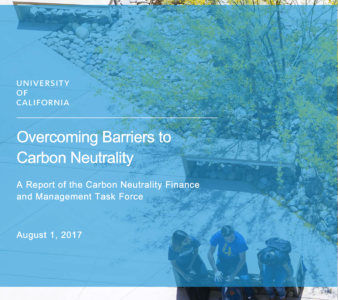Lessons From the University of California’s Carbon Neutrality Initiative
New Pritzker Brief Highlights Barriers to, Recommendations for, Getting to Zero Carbon Emissions by 2025

In 2013, University of California President Janet Napolitano announced that the system’s ten campuses and its central office would cut their carbon emissions to zero by 2025. The goal is one of the most ambitious organizational goals in the country. To help implement the Carbon Neutrality Initiative, the President appointed a Global Climate Leadership Council in 2014, comprised of faculty and administrators from around the system. I serve as a member of the GCLC.
After some time on the GCLS learning about the progress the campuses were making in cutting greenhouse gas emissions, several of us realized that although campuses were making impressive progress reducing emissions, achieving carbon neutrality in less than a decade would require more. Importantly, we would have to overcome not just technological barriers (like the availability of affordable biogas for the system’s seven co-generation plants or the procurement of 100 percent renewable energy to supply campus electricity), but also organizational, financial and communication obstacles. For example, how do we ensure that new construction — necessary to accommodate projected student growth – does not increase our carbon footprint? How do we maximize investments in energy efficiency when those investments sometimes take significant up front capital even if they pay off over time? How do we balance the carbon neutrality goal with other campus goals? How do we achieve campus buy-in from a diverse group of stakeholders? How do we transition away from large capital investments in co-generation plants in a way that doesn’t break the banks of our campuses? How do our medical centers achieve carbon neutrality while ensuring their number one goal, patient safety? How do we respect campus autonomy and campus differences while ensuring compliance with the goal?
To help answer these questions and more, President Napolitano asked me to chair a new task force, the Carbon Neutrality Finance and Management Task Force, to examine and make recommendations about these issues and more. Our then-Emmett/Frankel Fellow, Julia Forgie (now with the California Department of Justice), helped staff our work. The Task Force spent more than a year gathering data, interviewing dozens of stakeholders, conducting surveys, meeting with campus leaders who are or will be involved in helping meet the carbon neutrality goal, drafting a report, and using the report as a means to solicit more feedback, before issuing the final version, available here. Today, UCLA’s Emmett Institute on Climate Change and the Environment (co-authored by Julia and me) are releasing a new Pritzker brief that sets forth the principal financial, organizational, and communication barriers our Task Force identified and spells out our recommendations for overcoming those barriers. Our belief is that these issues are common to complex organizations seeking to cut carbon emissions deeply and that these organizations may benefit from learning about the University of California’s experience. Achieving deep cuts in an organization’s carbon emissions is possible, but doesn’t simply happen without careful attention to the internal workings and dynamics of the organization. Our brief and our task force report provide a way to being to evaluate those workings and dynamics.
Reader Comments
One Reply to “Lessons From the University of California’s Carbon Neutrality Initiative”
Comments are closed.







The University of California is not just a major consumer of fossil fuels and source of both direct and indirect greenhouse emissions; it is foremost an educational and research institution whose social responsibility, example and influence extend far beyond its campus boundaries — throughout the state, the nation and the globe.
Yet the scope of the “Global” Climate Leadership Council appears to be limited to internal policies, organization and finance. Beyond the simple category of “research,” where are the vision and initiatives for new technologies that will provide more abundant, economical and renewable green energy? Where are collaborations, sponsorships and partnerships with other organizations, both public and private, both statewide and beyond California? Where is the “leadership” necessary for unity of purpose and collective action beyond internal example?
When JFK delivered his “moonshot” speech in 1962, mankind had barely left the Earth’s atmosphere. Yet, before the decade was out, within 7 years, Neil Armstrong and Buzz Aldrin stepped on the moon. Now, after six decades have passed, it seems that we still find the Earth’s atmosphere to be a most formidable challenge.